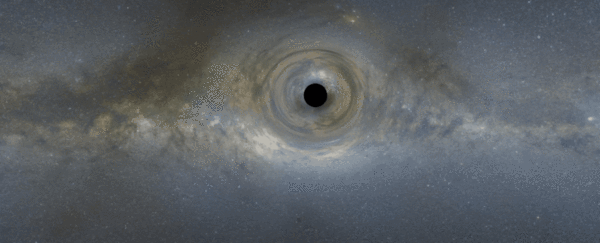The peculiar movement of gas at the galactic centre could be the smoking gun that finally leads astronomers to the most elusive type of black hole - the middleweight.
Black holes are pretty hard to find unless they're actively feeding (or colliding), since they don't emit any electromagnetic radiation (except perhaps for Hawking radiation, which, if it exists, we can't detect).
That's because electromagnetic radiation can't achieve escape velocity from beyond the event horizon; thus black holes are invisible to our detection methods when they're not doing something noticeable.
Still, we know there are stellar mass black holes, formed from the core collapse of a massive star, up to about 100 times the mass of the Sun; and supermassive black holes, starting from about 100,000 times the mass of the Sun.
Between these two extremes, though, is a whopping question mark. Although there has been pretty good indirect evidence that points to the existence of black holes between 100 and 100,000 solar masses, their existence has yet to be confirmed.
In other words, those black holes of unusual size? We're not sure they exist.
In a new paper published on preprint resource arXiv, and yet to be peer-reviewed, astronomers from the National Astronomical Observatory of Japan (NAOJ) have described evidence that points to one of these mythical beasts drifting around about 20 light-years from the centre of the Milky Way.
Using the Atacama Large Millimeter/Submillimeter Array (ALMA) radio telescope, they found streams of molecular gas orbiting what seems to be an invisible massive object.
"When I checked the ALMA data for the first time," astrophysicist Shunya Takekawa of the NAOJ told New Scientist, "I was really excited because the observed gas showed obvious orbital motions, which strongly suggest an invisible massive object lurking."
Similar high-velocity compact clouds have been observed as a result of collisions between supernova clouds, but the object - called HCN–0.009–0.044 - shows neither the shape nor the expansion pattern associated with a collision of this type.
Moreover, previous research, also from the NAOJ and co-authored by the team conducting this new research, had already identified HCN–0.009–0.044 as a possible black hole.
But now they've done something new. Based on the shape and movement of the gas streams, the team was able to infer that the object has a mass equivalent of around 32,000 Suns.
This makes it - if the paper passes peer review - a very strong contender for a black hole missing link, packing all that mass into an object roughly the size of Jupiter.
In addition to potentially discovering an intermediate black hole, the research points to what could be a new method of discovering inactive black holes.
As well as the motion of the gas, ionisation of the gas in the inner part of the orbit suggests that at some point, either photoionisation, dissociative shock, or both took place - ionisation processes seen in active black holes.
So if a black hole is intermittently active, it may produce ionisation that can be detected after it has quietened down again.
"Our results provide new circumstantial evidences for a wandering intermediate-mass black hole in the Galactic centre, suggesting also that high-velocity compact clouds can be probes of quiescent black holes abound in our Galaxy," the researchers wrote in their paper.
"[H]igh-resolution observations of compact high-velocity gas features have the potential to increase the number of candidates for non-luminous black holes, providing a new perspective to search for the missing black holes."
The paper can be read in full on arXiv.
